Abstract
To study apolipoprotein A-II, a simple, precise, and accurate immunodiffusion assay was developed and applied in a population sample of industrial employees. Apolipoprotein A-II (A-II) did not increase with age in men (r = −0.20, n = 172), but showed a slight increase with age in women (0.1 mg/dl per yr, r = 0.20, n = 188). A-II correlated significantly with apolipoprotein A-I (A-I) (r = 0.71) and high density lipoprotein (HDL) cholesterol (men, r = 0.64; women, r = 0.49). The A-I/A-II ratio was significantly related to HDL cholesterol (men, r = 0.29; women, r = 0.44). Women on no medication (n = 92) had A-II levels similar to men (34±5 and 33±5 mg/dl, mean±SD, respectively), whereas women on oral contraceptives or estrogens had significantly higher levels (39±6 mg/dl, n = 75, P < 0.01). The plasma A-I/A-II weight ratio was 3.6±0.4 for men and 3.8±0.5 for women. In the d = 1.10-1.21 subfraction, both males and females had similar A-I, A-II, and HDL cholesterol levels (men: mean, 97, 27, and 32 mg/dl, respectively; women: mean, 104, 28, and 36 mg/dl, respectively). Women had approximately twice the amount of A-I, A-II, and HDL cholesterol than men in the d = 1.063-1.10 fraction (men: mean, 10, 2, and 10 mg/dl, respectively; women: mean, 24, 4, and 19 mg/dl, respectively). The A-I/A-II weight ratio in the d = 1.063-1.10 fraction (men, 5.1±0.7; women, 6.1±1.3) was significantly greater (P < 0.01) than that in the d = 1.10-1.21 fraction (men, 3.7±0.2; women, 3.8±0.2). Furthermore, the weight ratio of cholesterol to total apoprotein A in the d = 1.063-1.10 fraction (men, 0.75±0.09; women, 0.67±0.05) was significantly higher (P < 0.01) than that found in the d = 1.10-1.21 fraction (men, 0.26±0.04, women, 0.28±0.05). Thus, the compositions of HDL hydrated density subclasses are significantly different from each other. These results suggest that the differences in HDL between men and women are due primarily to differences in the relative proportions of HDL subclasses rather than to the intrinsic differences in HDL structure.
Full text
PDF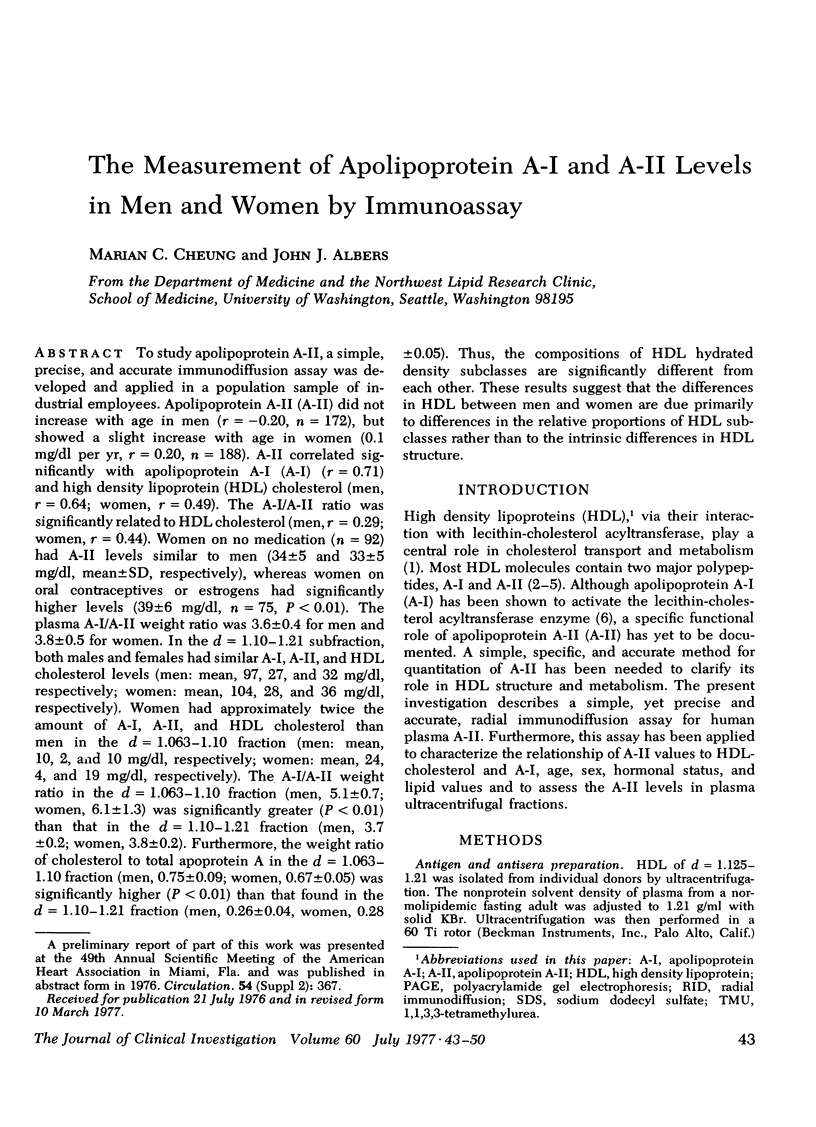
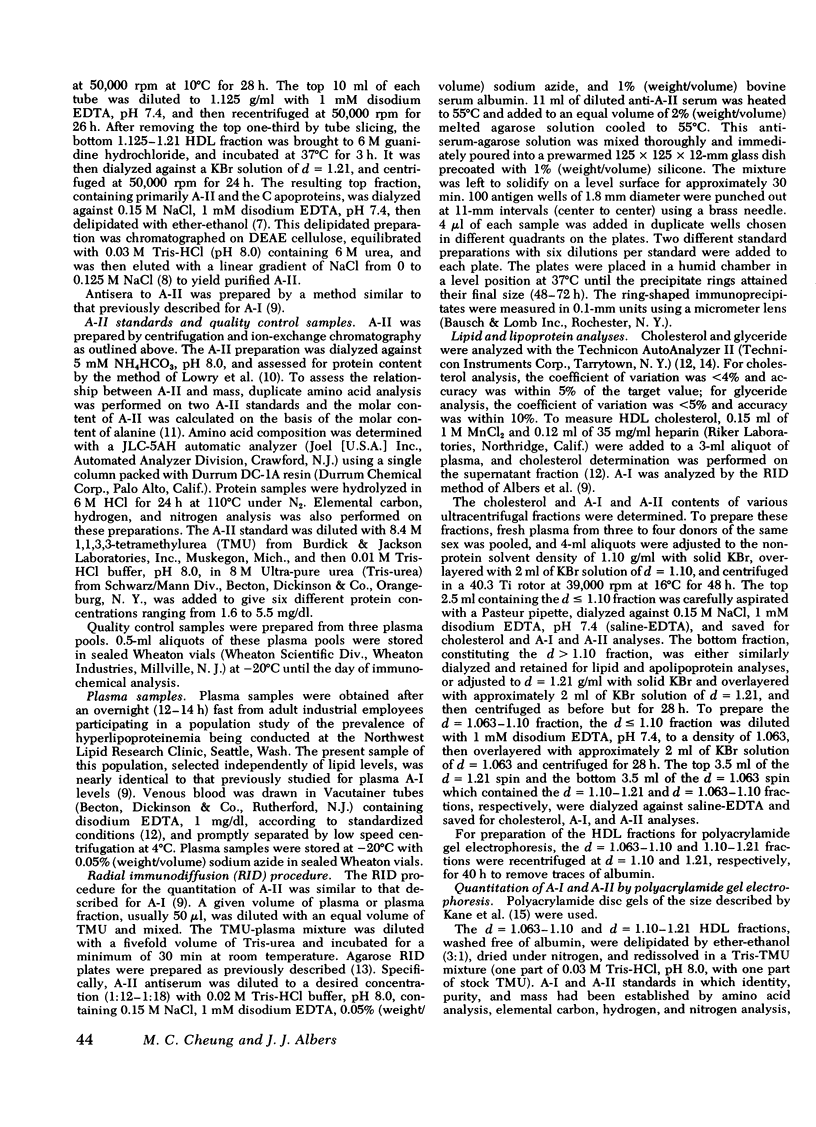
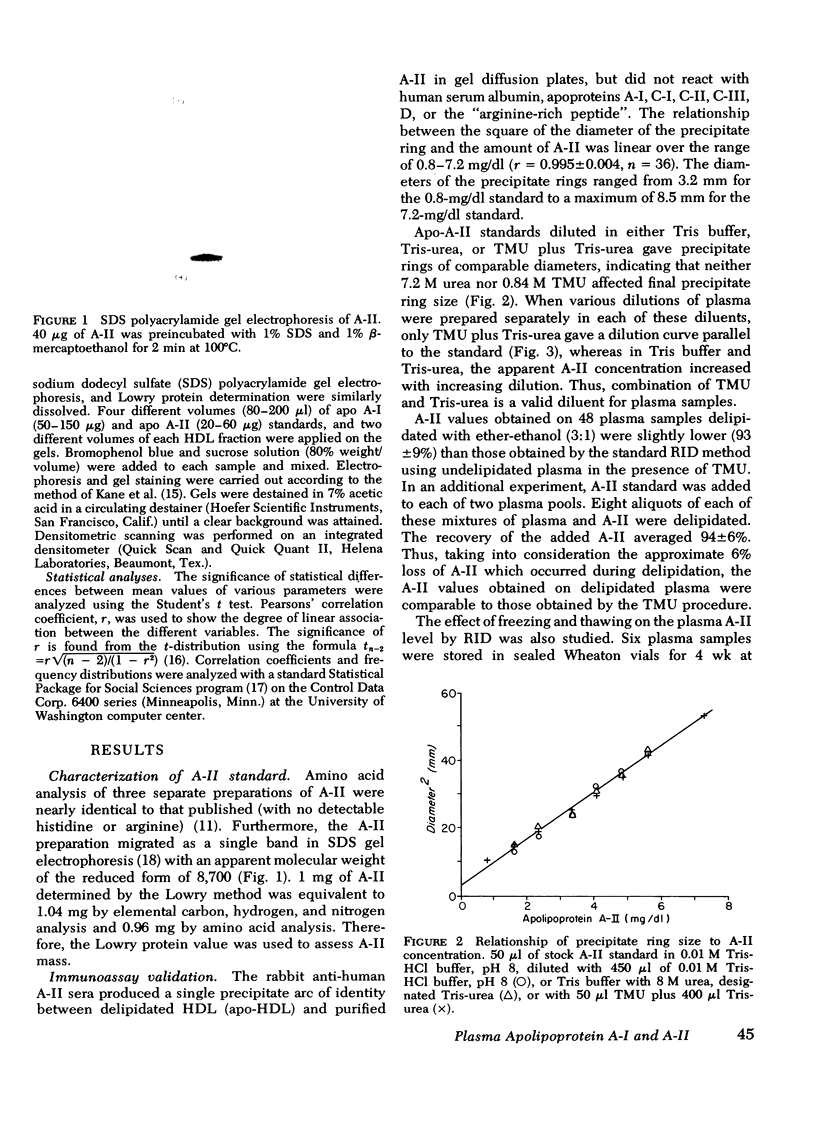
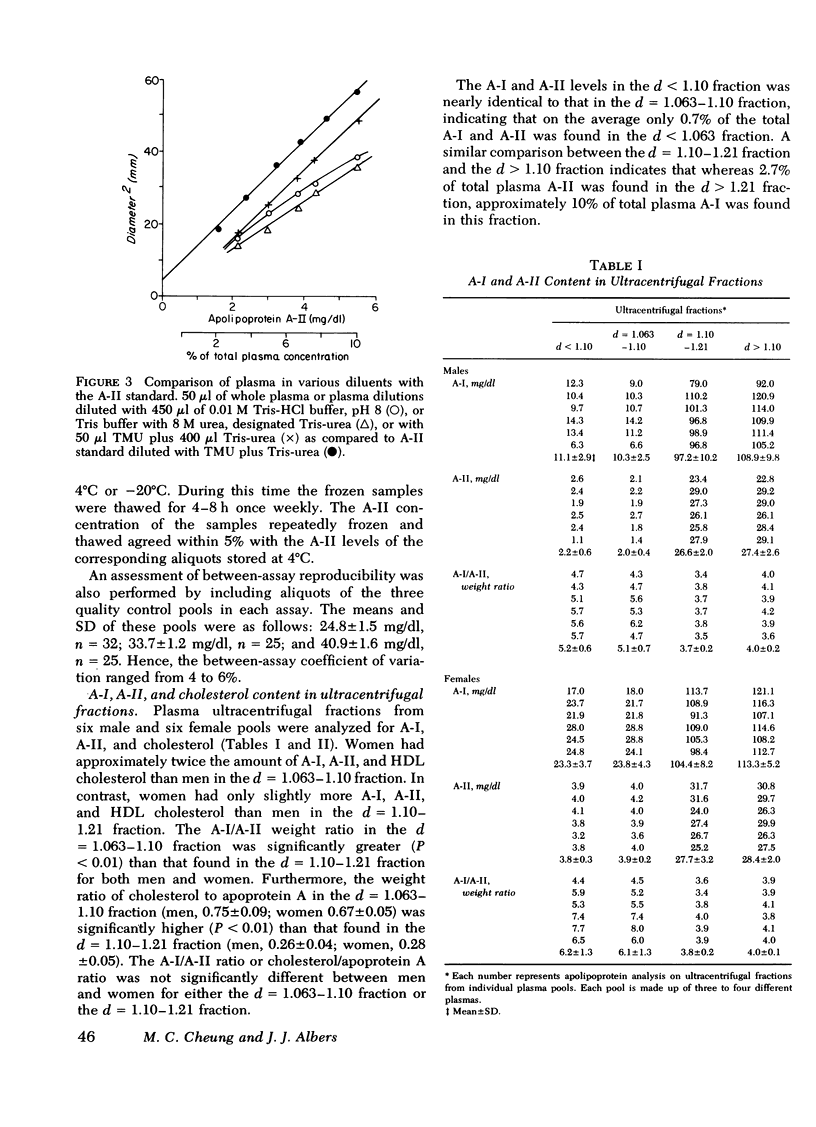
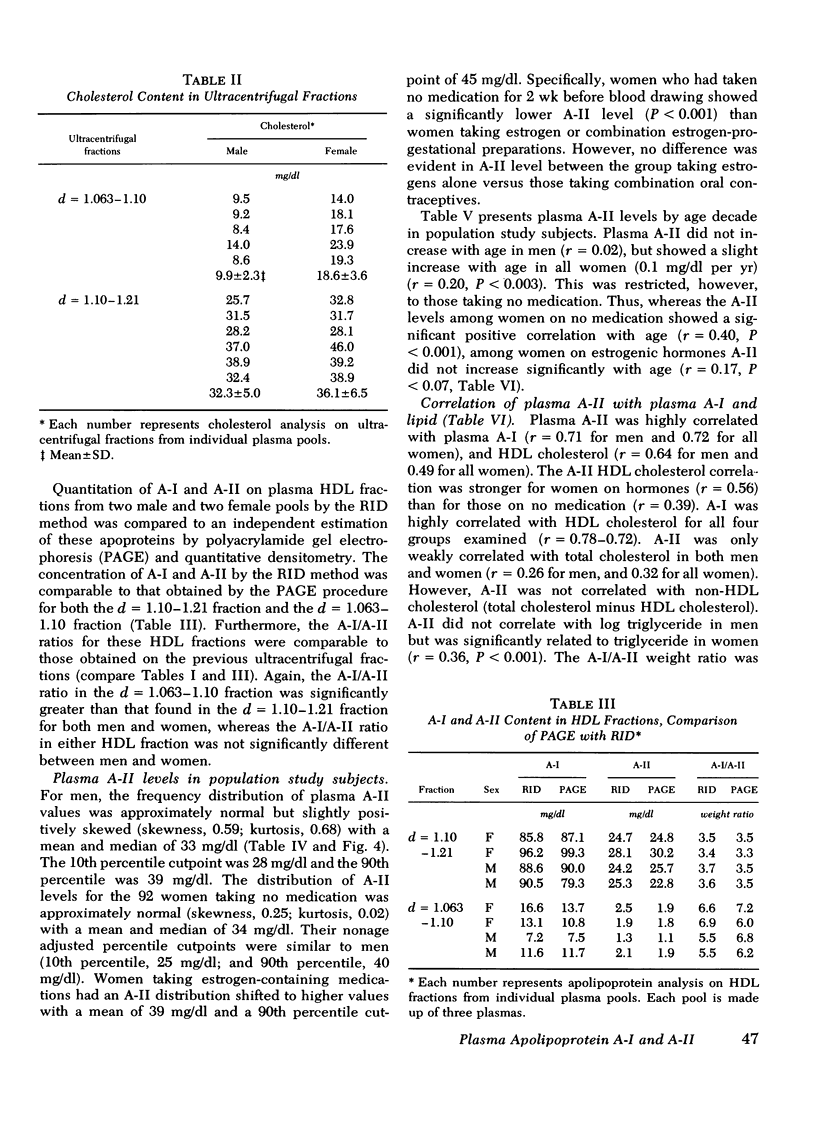
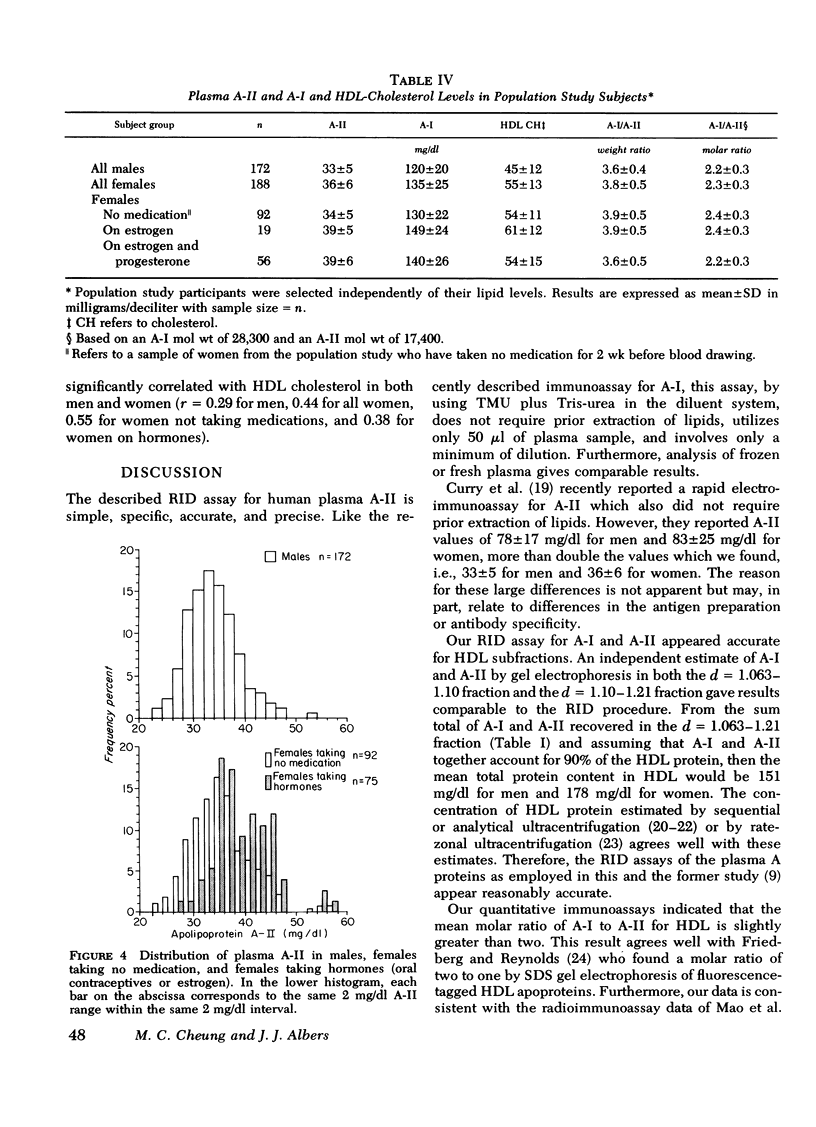
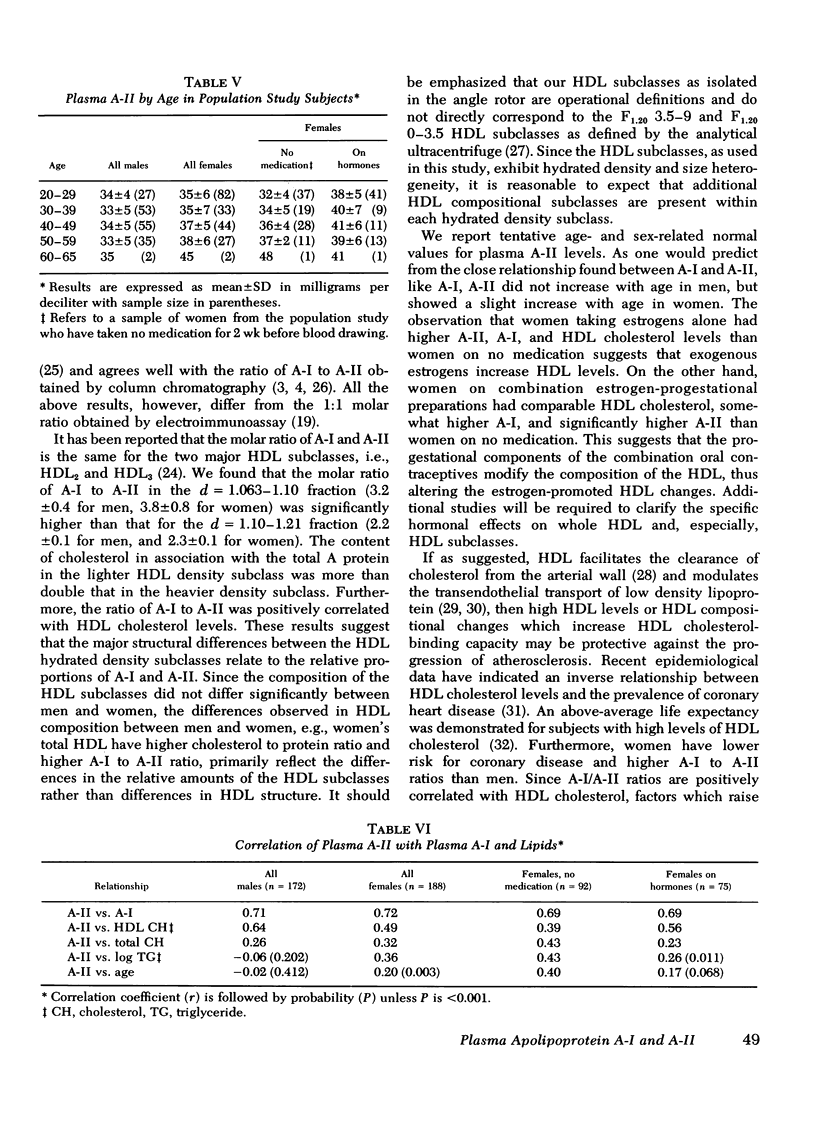
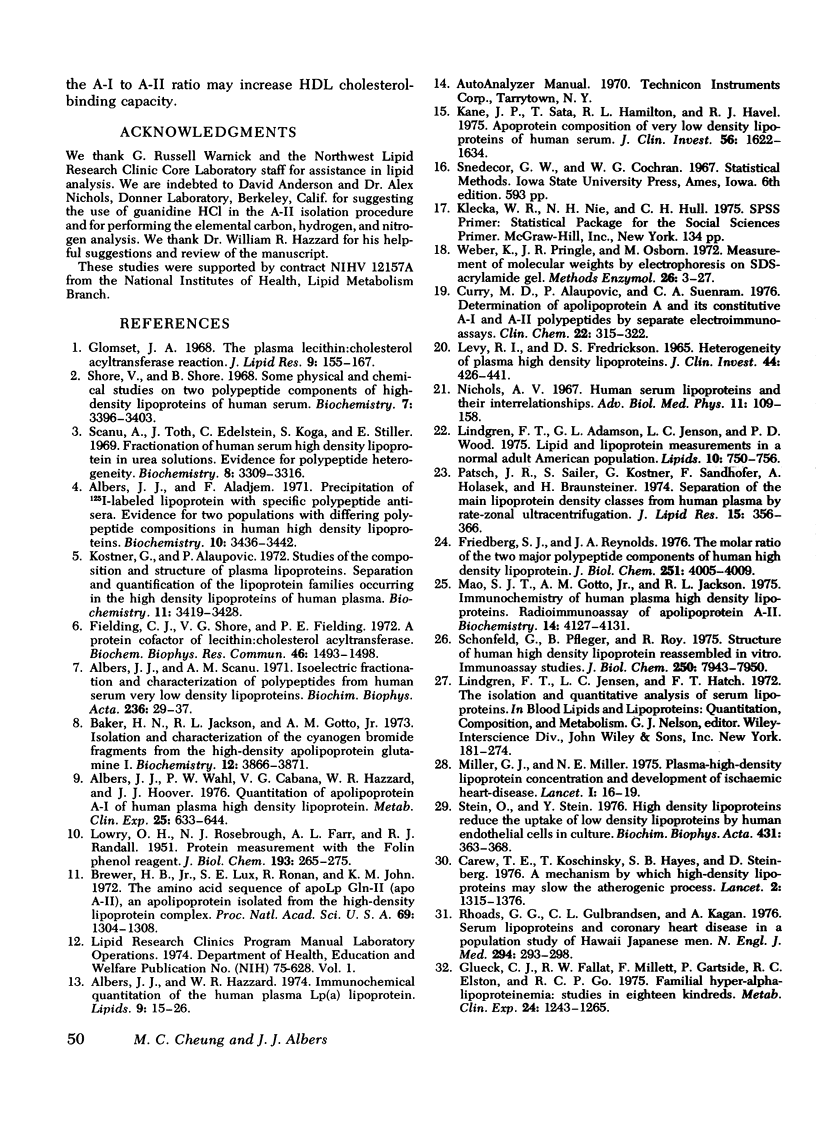
Images in this article
Selected References
These references are in PubMed. This may not be the complete list of references from this article.
- Albers J. J., Aladjem F. Precipitation of 125 I-labeled lipoproteins with specific polypeptide antisera. Evidence for two populations with differing polypeptide compositions in human high density lipoproteins. Biochemistry. 1971 Aug 31;10(18):3436–3442. doi: 10.1021/bi00794a019. [DOI] [PubMed] [Google Scholar]
- Albers J. J., Hazzard W. R. Immunochemical quantification of human plasma Lp(a) lipoprotein. Lipids. 1974 Jan;9(1):15–26. doi: 10.1007/BF02533209. [DOI] [PubMed] [Google Scholar]
- Albers J. J., Scanu A. M. Isoelectric fractionation and characterization of polypeptides from human serum very low density lipoproteins. Biochim Biophys Acta. 1971 Apr 27;236(1):29–37. doi: 10.1016/0005-2795(71)90145-0. [DOI] [PubMed] [Google Scholar]
- Albers J. J., Wahl P. W., Cabana V. G., Hazzard W. R., Hoover J. J. Quantitation of apolipoprotein A-I of human plasma high density lipoprotein. Metabolism. 1976 Jun;25(6):633–644. doi: 10.1016/0026-0495(76)90060-3. [DOI] [PubMed] [Google Scholar]
- Baker H. N., Jackson R. L., Gotto A. M., Jr Isolation and characterization of the cyanogen bromide fragments from the high-density apolipoprotein glutamine I. Biochemistry. 1973 Sep 25;12(20):3866–3871. doi: 10.1021/bi00744a011. [DOI] [PubMed] [Google Scholar]
- Brewer H. B., Jr, Lux S. E., Ronan R., John K. M. Amino acid sequence of human apoLp-Gln-II (apoA-II), an apolipoprotein isolated from the high-density lipoprotein complex. Proc Natl Acad Sci U S A. 1972 May;69(5):1304–1308. doi: 10.1073/pnas.69.5.1304. [DOI] [PMC free article] [PubMed] [Google Scholar]
- Carew T. E., Koschinsky T., Hayes S. B., Steinberg D. A mechanism by which high-density lipoproteins may slow the atherogenic process. Lancet. 1976 Jun 19;1(7973):1315–1317. doi: 10.1016/s0140-6736(76)92650-7. [DOI] [PubMed] [Google Scholar]
- Curry M. D., Alaupovic P., Suenram C. A. Determination of apolipoprotein A and its constitutive A-I and A-II polypeptides by separate electroimmunoassays. Clin Chem. 1976 Mar;22(3):315–322. [PubMed] [Google Scholar]
- Fielding C. J., Shore V. G., Fielding P. E. A protein cofactor of lecithin:cholesterol acyltransferase. Biochem Biophys Res Commun. 1972 Feb 25;46(4):1493–1498. doi: 10.1016/0006-291x(72)90776-0. [DOI] [PubMed] [Google Scholar]
- Friedberg S. J., Reynolds J. A. The molar ratio of the two major polypeptide components of human high density lipoprotein. J Biol Chem. 1976 Jul 10;251(13):4005–4009. [PubMed] [Google Scholar]
- Glomset J. A. The plasma lecithins:cholesterol acyltransferase reaction. J Lipid Res. 1968 Mar;9(2):155–167. [PubMed] [Google Scholar]
- Glueck C. J., Fallat R. W., Millett F., Gartside P., Elston R. C., Go R. C. Familial hyper-alpha-lipoproteinemia: studies in eighteen kindreds. Metabolism. 1975 Nov;24(11):1243–1265. doi: 10.1016/0026-0495(75)90063-3. [DOI] [PubMed] [Google Scholar]
- Kane J. P., Sata T., Hamilton R. L., Havel R. J. Apoprotein composition of very low density lipoproteins of human serum. J Clin Invest. 1975 Dec;56(6):1622–1634. doi: 10.1172/JCI108245. [DOI] [PMC free article] [PubMed] [Google Scholar]
- Kostner G., Alaupovic P. Studies of the composition and structure of plasma lipoproteins. Separation and quantification of the lipoprotein families occurring in the high density lipoproteins of human plasma. Biochemistry. 1972 Aug 29;11(18):3419–3428. doi: 10.1021/bi00768a015. [DOI] [PubMed] [Google Scholar]
- LEVY R. I., FREDRICKSON D. S. HETEROGENEITY OF PLASMA HIGH DENSITY LIPOPROTEINS. J Clin Invest. 1965 Mar;44:426–441. doi: 10.1172/JCI105156. [DOI] [PMC free article] [PubMed] [Google Scholar]
- LOWRY O. H., ROSEBROUGH N. J., FARR A. L., RANDALL R. J. Protein measurement with the Folin phenol reagent. J Biol Chem. 1951 Nov;193(1):265–275. [PubMed] [Google Scholar]
- Lindgren F. T., Adamson G. L., Jenson L. C., Wood P. D. Lipid and lipoprotein measurements in a normal adult American population. Lipids. 1975 Dec;10(12):750–756. doi: 10.1007/BF02532316. [DOI] [PubMed] [Google Scholar]
- Miller G. J., Miller N. E. Plasma-high-density-lipoprotein concentration and development of ischaemic heart-disease. Lancet. 1975 Jan 4;1(7897):16–19. doi: 10.1016/s0140-6736(75)92376-4. [DOI] [PubMed] [Google Scholar]
- Nichols A. V. Human serum lipoproteins and their interrelationships. Adv Biol Med Phys. 1967;11:109–158. doi: 10.1016/b978-1-4832-3107-5.50008-x. [DOI] [PubMed] [Google Scholar]
- Patsch J. R., Sailer S., Kostner G., Sandhofer F., Holasek A., Braunsteiner H. Separation of the main lipoprotein density classes from human plasma by rate-zonal ultracentrifugation. J Lipid Res. 1974 Jul;15(4):356–366. [PubMed] [Google Scholar]
- Rhoads G. G., Gulbrandsen C. L., Kagan A. Serum lipoproteins and coronary heart disease in a population study of Hawaii Japanese men. N Engl J Med. 1976 Feb 5;294(6):293–298. doi: 10.1056/NEJM197602052940601. [DOI] [PubMed] [Google Scholar]
- Scanu A., Toth J., Edelstein C., Koga S., Stiller E. Fractionation of human serum high density lipoprotein in urea solutions. Evidence for polypeptide heterogeneity. Biochemistry. 1969 Aug;8(8):3309–3316. doi: 10.1021/bi00836a027. [DOI] [PubMed] [Google Scholar]
- Schonfeld G., Pfleger B., Roy R. Structure of human high density lipoprotein reassembled in vitro. Radioimmunoassay studies. J Biol Chem. 1975 Oct 10;250(19):7934–7950. [PubMed] [Google Scholar]
- Shore V., Shore B. Some physical and chemical studies on two polypeptide components of high-density lipoproteins of human serum. Biochemistry. 1968 Oct;7(10):3396–3403. doi: 10.1021/bi00850a013. [DOI] [PubMed] [Google Scholar]
- Stein O., Stein Y. High density lipoproteins reduce the uptake of low density lipoproteins by human endothelial cells in culture. Biochim Biophys Acta. 1976 May 27;431(2):363–368. doi: 10.1016/0005-2760(76)90157-0. [DOI] [PubMed] [Google Scholar]
- Weber K., Pringle J. R., Osborn M. Measurement of molecular weights by electrophoresis on SDS-acrylamide gel. Methods Enzymol. 1972;26:3–27. doi: 10.1016/s0076-6879(72)26003-7. [DOI] [PubMed] [Google Scholar]



